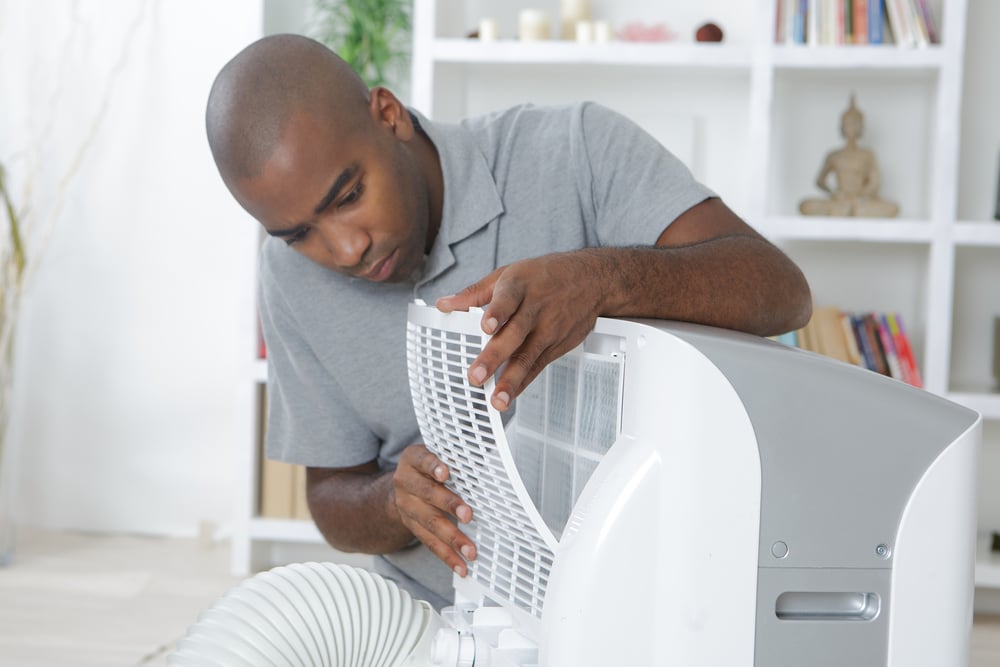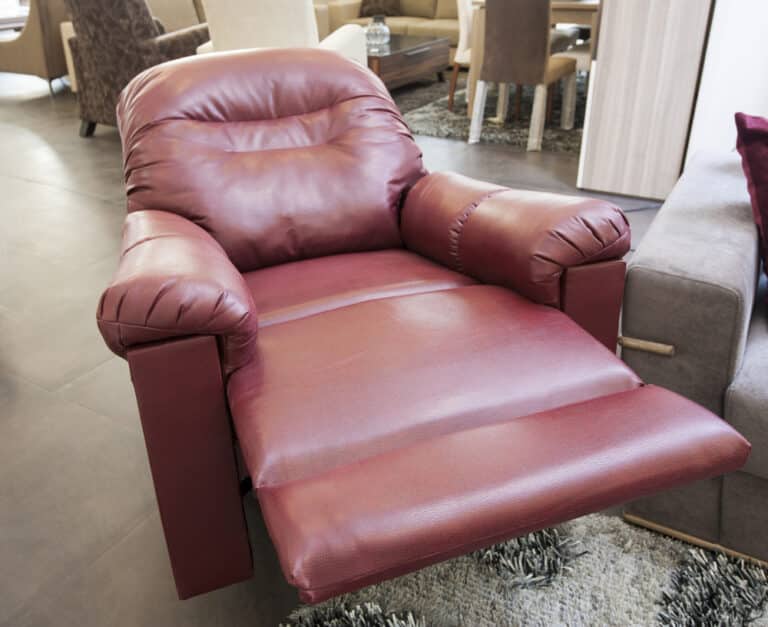Keeping cool indoors during summer can be a challenging task with no air conditioning unit. Luckily, portable air conditioners are simple to set up to welcome a cooling temperature into your living area while keeping hot air outside of your home. How does a portable air conditioner work? We’re sharing all, along with a buying guide, in this article.
What Is a Portable Air Conditioner?
A portable air conditioner is a unit that’s designed for cooling a single room that typically sits on the floor and comes with a quick set-up installation kit. In general, portable air conditioners are more popular and preferred than window air conditioners because certain models come with wheels to transfer to different rooms easily.
How Does a Portable Air Conditioner Work?
Portable air conditioners absorb hot air from the air and push new, chilled air back into the same space. Also, portable air conditioners push this internal warm air through an exhaust hose that connects to your home’s window, ceiling or wall. For optimal airflow, you can control the settings on the unit, including fan speed and temperature. Compared to air coolers, a portable air conditioner doesn’t use water to cool spaces, making it more effective to use.
The Benefits of a Portable Air Conditioner
So why should you purchase a portable air conditioner, and what are the benefits of using AC units?
No Installation Required
Although portable air conditioners work wonders with cleaning the air in your home, they’re easy and quick to set up. Simply unpack the air conditioner, connect it to an electrical outlet and switch on the AC unit.
They’re Portable
As the name suggests, a portable AC unit is moveable, so you can transfer it from room to room to suit your needs. This is great for not having to purchase multiple portable air conditioners in your home while keeping different areas cool. Therefore, you can switch the portable AC unit from the living room to the bedroom. Many air conditioning units come with wheels, which also makes them easy to transfer to different rooms.
Simple Cooling Solution
Another great benefit of portable air conditioners is their simplicity. As they don’t require an external condenser unit, it’s easy to connect and detach portable air conditioners as and when you need them. Additionally, this is ideal if you have limited space in your home since portable air conditioners boast a discreet design for storing in any room of your home.
A Cheaper Alternative to Other Cooling Systems
Portable air conditioners aren’t as expensive as other cooling systems, such as wall-mounted air conditioning units. The upfront cost of portable air conditioners is less costly, and they’re not expensive to run. Portable air conditioners can save you money in the long run by removing the burden from a central air conditioning unit.
You can use portable air conditioners for small to medium-sized rooms, making them great for living spaces or small shops. You’ll also not have the commitment of a fully fixed internal unit.
Size and Rating
Portable AC units come in a range of sizes and ratings so that you can choose the right unit for the size of your room. In particular, most portable air conditioning units range from 5,000 to 40,000 BTU. So you’ll have a range of options to suit your needs.
Factors to Consider When Buying a Portable Air Conditioner
If you like the sound of the benefits you can get with portable air conditioners, it might be time to consider purchasing one. If so, here are some important factors to keep in mind during the buying process.
Size
The first factor to keep in mind is what size portable air conditioner you’ll need. To make this decision, ask yourself if you’ll want to move the air conditioning unit into different rooms, which is totally possible. If so, consider a smaller option that’s easier to transport back into the room. Otherwise, you’ll end up struggling when trying to navigate the unit inside the room.
Additionally, do you want to fit the unit inside of your car to take you to various places? Then you’ll want a unit with wheels and preferably handles to make it easier to manoeuvre to your vehicle as well as lift it into the boot.
Aside from these factors, you should know where you plan to store the portable AC unit inside your room. Once you’ve decided on the space, take measurements, so you know how much spare room you have for the unit to fit into that area. You can always rearrange the furniture in your room to accommodate the appliance, but some people prefer to fit portable ACs into their current living situation.
Energy Usage
A portable air conditioning unit will use less energy than a central air conditioning appliance, but they still cost money to operate. Fortunately, it’s not a challenging process to find the best portable air conditioning unit to cool your room because Energy Star provides clear ratings for every unit, enabling you to compare specific models on their energy efficiency.
If saving money and energy is critical to you, we highly recommend considering portable units that have a pre-installed thermostat that switches off once the room reaches the desired temperature. This ensures that the appliance doesn’t continue trying to cool the room when it’s reached your preferred temperature. Additionally, cleanliness and maintenance can affect how units work, including their energy efficiency, so research how easy it is to clean your preferred model.
Single-Hose vs Dual-Hose Units
It’s now time to look into the ventilation of the portable AC unit you’re considering. At this point, you might be aware that you have the choice of a one-hose or a second-hose unit.
As the name suggests, a single-hose unit only contains one hose, which is used for the intake and extraction of air. These types of AC units typically have to work harder, but they will still cool the air.
On the other hand, a dual-hose portable air conditioner is more energy-efficient and can cool air 40% quicker than the alternative. This is because they feature two hoses that work at the same time, making hot air from the room cool in no time.
Noise
Portable air conditioners work hard to remove warm air and moisture from the air, so naturally, they’ll generate noise as they work. For most air conditioning units, this noise isn’t any more than background bustle, but it’s still worth researching the volume of your chosen unit to see if it’ll interfere with your daily tasks or watching the TV.
Ideally, you don’t want your air conditioning unit to exert so much noise that it becomes disruptive in your home. So look at the customer reviews and the unit’s decibels to see if you’re happy with the noise level.
Features
Thermostat
Portable air conditioners work with a host of features that do more than simply cool air. For example, a high-end model will include a programmable thermostat that allows you to see the desired temperature inside your home. The unit will then switch off once it’s reached this temperature. This feature allows you to reserve energy and, thus, the overall cost of operating the unit, as well as reducing the need to manually switch it on and off.
Gravity Drain
Another built-in feature to consider is a gravity drain that turns any liquid from condensations into the exhaust hose, meaning that you never have to empty anything out of the unit. This is particularly important for people individuals and those looking for an appliance that does it all.
Heater

You might not have enough storage space in your home for a separate portable air conditioner and heater, which is why you might want to consider a system that has a combination of both. This makes the unit great for use throughout the year without you having to purchase two separate appliances and find some places in the house to store them.
Remote Control
For ease of use, an included remote control allows you to change the fan speed, temperature and even automate a running schedule without having to get up and adjust these settings manually on the AC unit. This is great if you’re already in bed and don’t feel like getting up to hit a few buttons.
Dehumidifier
Finally, an air conditioner that also operates as a dehumidifier is beneficial for removing dampness from the air and eliminating any concerning health conditions in your home. Again, a portable cooling system with this additional feature means that you don’t have to purchase a separate air dehumidifier unit.
Want to Recommend a Portable Air Conditioner Model?
So how does a portable air conditioner work? Portable air conditioners work by extracting heat from a room and circulating this air to a cooler temperature. Many of the best appliances allow you to control the fan speed as well as temperature. They also don’t use any water, so there’s virtually no maintenance required. Do you have a portable air conditioner that you swear by? Share the brand and model in the comments.







